
England’s miserable Test tour of Australia was completed as they were swept aside by an innings and 123 runs in Sydney to slide to a 4-0 Ashes series defeat.
Here, Press Association Sport considers the reasons for a comprehensive loss.
A message to our amazing supporters here and back home from @jimmy9… pic.twitter.com/FPWvyvVu2E
— England Cricket (@englandcricket) January 8, 2018
Discipline
— Ben Stokes (@benstokes38) November 22, 2017
The moment Ben Stokes was arrested over a late-night incident in Bristol the entire tenor of the Ashes shifted. Stokes was more than England’s vice-captain, more than their fourth seamer and more than their most effective counter-attacking batsman. He was the side’s heart and soul and the pivot around which the rest of the side balanced. The precise details are yet to be established by police but at the least he fell short of the highest professional standards in the midst of an international series against the West Indies. Jonny Bairstow took a loose view of the management’s subsequent warnings over behaviour when he bizarrely, but apparently playfully, greeted Australia opener Cameron Bancroft with a bar-room headbutt. By the time Lions batsman Ben Duckett poured a drink on James Anderson’s head in the same Perth bar, the tour was more derailed off the pitch than on it.
Cut to the quick

England proved in 2010-11 that a raw pace barrage was not essential to victory in Australia, but the greater weight of evidence suggests it is certainly pretty handy. Australia’s seamers were uniformly quicker than their counterparts and in the absence of sustained movement through the air the touring attack looked pedestrian and repetitive. Indeed, England failed to take 20 wickets in any of the five matches in this series. Anderson and Stuart Broad are champion bowlers but did not threaten the top order consistently, Tom Curran showed plenty of effervescence but had minimal impact, while it is hard to imagine a youngster of Craig Overton’s physical dimensions being allowed to settle for 80mph nibblers were he taught in Sydney rather than Somerset.
Root cause

A successful tour for England always required a major showing from their captain, Joe Root. Widely accepted as the class act in a hastily-assembled top six, his much-maligned trait of failing to capitalise on starts reared its head once again. He passed 50 five times over the course of the series but not once did he reach three figures. Contrast that with opposite number and peer on most pundits’ ‘best in the world’ lists, Steve Smith, an imperious and immovable force who averaged 137.4 – a startling figure even by his lofty standards. Root ended the series with questions about whether the captaincy of a side in transition is too much to place on his shoulders. Draining spells in the field cannot have helped him at the crease.
Moeen missing in action

Moeen Ali was England’s go-to man in the domestic summer, a match-winning presence in the lower order and an increasingly reliable attacking spinner against South Africa and the West Indies. What Root would have given to harness some of that in Brisbane and beyond. A side strain and a cut spinning finger saw him struggle for meaningful practice before the series and he never really found his feet thereafter. Unable to match Nathan Lyon for threat or control, his bowling has hit a nadir, while meaningful runs were lacking and a frenetic innings in Melbourne was widely panned.
Crucial moments

In spite of all of the above, there were moments, however brief, when England were at least causing minor strife for their hosts. It was most notable in Brisbane when Australia slipped to 209 for seven in response to 302, only to eke out a first-innings lead thanks to a majestic, atypical hundred from Smith. The home side’s second-innings collapse in Adelaide failed to alter the second Test dynamic, but England’s collapse from 368 for four to 403 all out in Perth and then 228 for three to 346 all out in Sydney sowed the seeds of their own downfall. Their impotence at the crucial moments was ruthlessly exploited by Australia, who pressed home their advantage time and time again.


Comments: Our rules
We want our comments to be a lively and valuable part of our community - a place where readers can debate and engage with the most important local issues. The ability to comment on our stories is a privilege, not a right, however, and that privilege may be withdrawn if it is abused or misused.
Please report any comments that break our rules.
Read the rules here